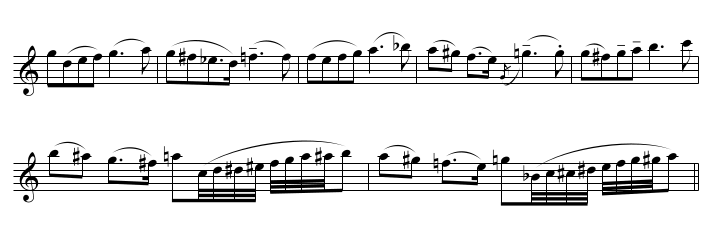The problem with augmented and diminished intervals
Augmented and diminished intervals are difficult to play in tune. First of all, it is difficult to hear the intervals correctly in our head. These are uncomfortable intervals, and subconsciously we try to 'fix' them by making them into a minor, major, or perfect interval. For instance, when we play an augmented 4th, it sounds uncomfortable so we tend to 'fix' it to a perfect 4th.
To make the problem worse, augmented and diminished intervals require our hand to stretch or contract.
Characteristics of augmented and diminished intervals
What makes augmented and diminished intervals unique is that they are extra wide and narrow intervals respectively. Once we get used to those intervals, we can cherish the extra wideness and narrowness by exaggerating the intervals. By doing so, we can make them sound more in tune and more musical.
Augmented intervals
Let's look at some examples to better understand this concept.

This is the opening passage of the Violin Concerto by Glazunov. There is an augmented 2nd in the 2nd measure. You can make it sound more in tune and musical by playing the 'D♯' high enough, and the 'C' low enough.
Because the augmented 2nd motif is in the first theme, it keeps coming back throughout the movement as you see in the example below.

So far, these augmented 2nds are moving downward, but later in the piece, you will see them going upward, like this:

What is unique about an augmented 2nd is that it is extra wide. Musically, it sounds more satisfying to make it purposely wide when you play.
This is a bit off topic, but in fact, these intervals should be wider than what a piano can play. We will not get into details in this article, but in a sense, piano is never really in tune no matter how well it is tuned. I say "in a sense" because there are several different ways to tune a scale, and the piano can be considered in tune or out of tune depending on which temperament we are talking about. For now, it is good enough to know that you shouldn't always rely on the piano to play in tune, and with the violin, you can play even more in tune than a piano can if you know when to apply which tuning method.
Diminished intervals
Let's think about diminished intervals with some examples. The first excerpt is from String Quintet, K.516 by Mozart.

There is a diminished 7th in the 3rd measure. We can make these notes more in tune by playing the B♭ lower and C♯ higher, thus making the interval especially narrow.
Here is another example of a diminished interval.

This excerpt is from the last movement of Terzetto Op.74 by Dvořák. There is no diminished interval at a glance, but when you look closer at the end of the 3rd measure, you will notice that there is an 'A♭' and an 'F♯'. There is a 'G' in the middle, but the 'A♭' is still lingering when you play the 'F♯', so these two notes are making a diminished 3rd. We can make this phrase sound more in tune and musical by playing the 'F♯' higher than usual. Don't touch the 'A♭' because otherwise the A♭ major chord will be out of tune.
Learn to enjoy the intervals, rather than to suffer from them
Augmented and diminished intervals sound delightful when executed appropriately. Because these are unusual intervals, they will have a tremendous effect on the music if we know how to deal with them. After all that is why the composers wrote them in their works. We should be keen to notice them and make minor adjustments in pitch to make the most out of these special intervals.